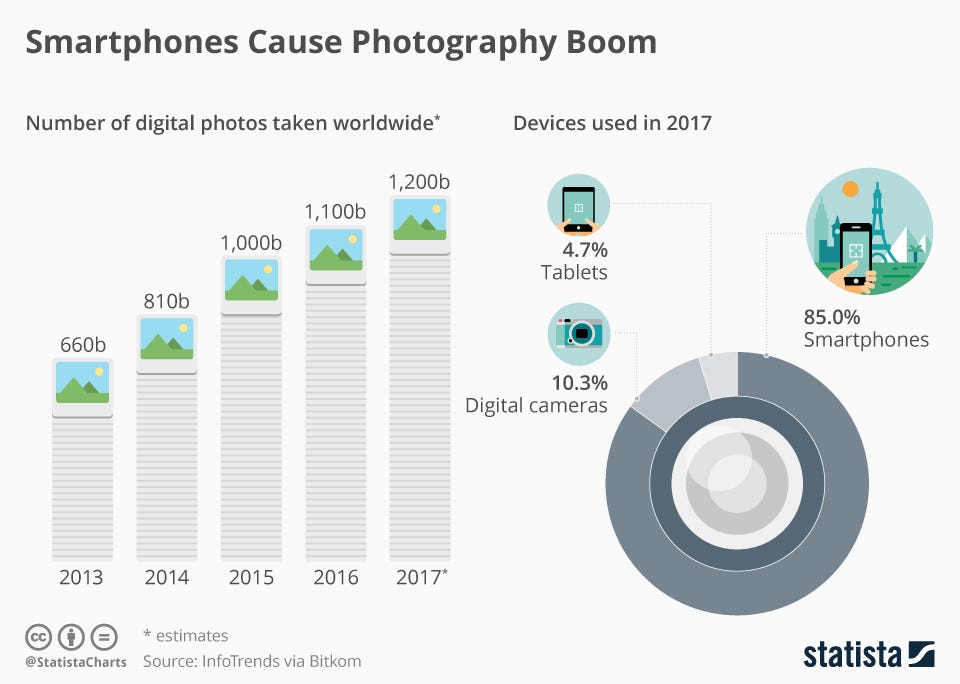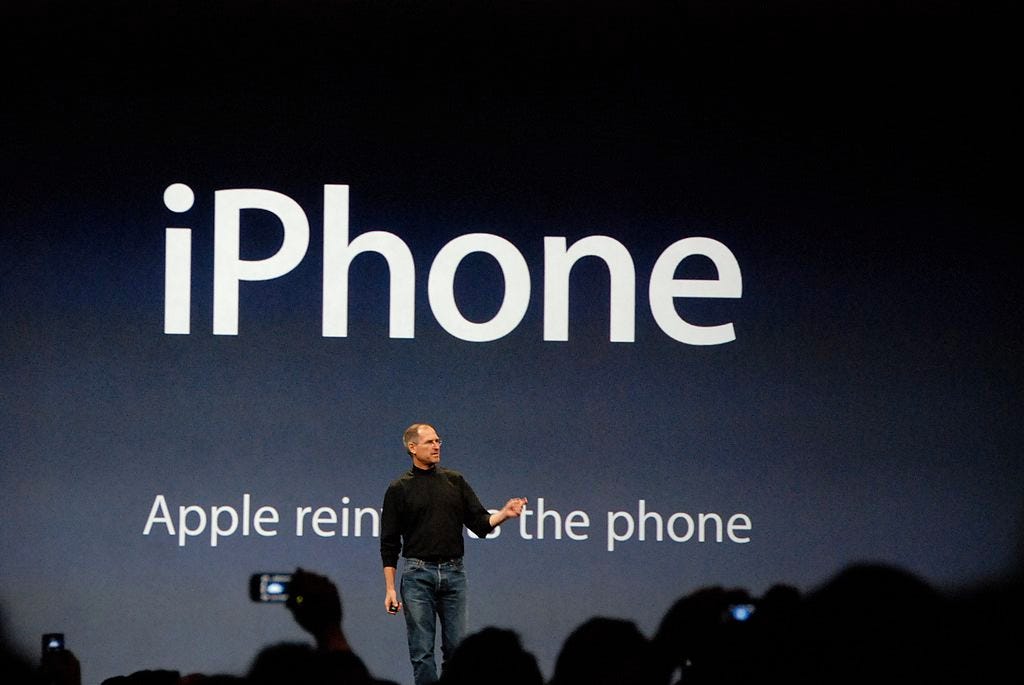What Happened To The Camera Industry
The Decease of the Camera
Lessons from our smartphones absorbing an entire industry

"The best photographic camera is the ane that's with you"
— Chase Jarvis, award-winning lensman
Cameras. For decades on end, the photography manufacture would seem to be virtually impermeable to contest. People and businesses needed photographs, and there was simply ane de facto way to capture them. And that began and ended with a camera — as a stand-alone device. Whether there was bodily film involved in the procedure or not, there needed — past definition —to be a camera involved with the photograph-capturing process to produce a film or digital-based photo.

Fast forwards to the world of today, where anybody seemingly has a high-resolution camera in their pocket or their purse. And suddenly, the province of professional photographers, from portrait to wedding to baby to news photographers and everyone in between, has been taken over by anyone — and seemingly everyone — with a smartphone.
The bottom-line for those making digital cameras is this: quite ironically, at a time when we are taking more photos than ever, cameras are a dying industry. As you can encounter in the infographic below from the analyst firm, Statista, 1.ii trillion digital photos were taken globally in 2017, roughly doubling in just a five yr period. Notwithstanding, digital cameras are being used by just about 1 in ten moving-picture show-takers, showing merely how much we have come up to rely upon the ever-increasing photographic capabilities in our smartphones for taking photos and videos for coincidental, and even for professional, purposes today.

Want farther testify of just how far and how fast the camera market has fallen? Take a look at the chart below, as well from Statista. Over the course of the fifteen-yr period reviewed through 2018, you tin can come across basically the unabridged product life cycle for digital cameras. In 2003, equally digital technology began to supervene upon the venerable motion-picture show standard that had been in place basically for a century and a half, y'all can nautical chart the rapid growth of the digital camera market, more than than doubling in size over the 5 year flow from 2003–2007!

Then, of grade, it happened! In Jan 2007, Steve Jobs strolled onto a stage in San Francisco and introduced the world to the iPhone, and after that, so many things were disrupted. Ane of the areas that suffered the worst of all was the camera concern. With the appearance of the smartphone, the digital camera was soon made a redundant device, as the smartphone became your default camera. And equally the capabilities of smartphones increased with each successive iPhone generation, likewise as with its ain rivals, a separate camera became unnecessary for most of us to buy or to even use.

Soon, so, the digital camera market place peaked in the 2008–2010 period. Smartphones really started to explode in usage, and it has fallen basically always since. In the U.Due south. lone, sales of digital cameras fell from fifteen.34 million units in 2013 to just 5.55 million terminal year. And in market surveys today, less than 1 in ten American consumers even plan to buy a digital photographic camera.
Equally you lot can see in the overall sales data, since 2015, the digital camera market has in some sense stabilized, fifty-fifty if information technology at an overall sales volume one-half of what it was in 2003! And the nature of the digital cameras beingness sold has changed markedly — over roughly the nigh recent 5 year period, those with interchangeable lenses now outsell the simpler models with built-in lenses. And according to a marketplace analysis from Fortune Business organization Insights, the global market for both photographic camera housings and increasingly powerful — and expensive — interchangeable lenses will really run into significant growth over the next decade. Driven by need from users — both casual and professional person — to capture better images and video from sports, travel, nature, and more, this role of the digital camera marketplace promises to exist the existent growth driver of a much smaller, but stable digital photographic camera market. The leading players in the field are reaching the long maturity stage of the life cycle for its products.
Assay
Then, what are the lessons to exist derived from the ascent, fall, and now stabilization of the digital photographic camera marketplace? As a strategic management consultant and professor, permit me offer three "lessons learned" that readers should take away from this tale of the nativity, growth, maturity, and in some means, well-nigh-expiry of this market place — which has taken identify over really just the past ii decades.
- You tin recollect yous take the "winning" innovation, simply to be supplanted past the "Next Big Matter" — and sooner than you may e'er dream! When you look at the camera market, realize just what a truly revolutionary device the digital camera was in its day in the early 2000s. With a digital camera, gone were the days of "just" existence able to take as many pictures as your roll of picture show was long. Y'all were no longer express to just 24 or 36 shots before having to modify out rolls of film. Indeed, as memory and retentivity devices grew in size, they decreased in price (a variation of Moore'due south Law at piece of work). One could shoot tens or even hundreds of pictures without stopping to "reload." And perhaps even more importantly, digital cameras immune both professional person and amateur photographers alike to instantly review their work. Teens and even twentysomethings today probable can't relate to the world of picture show photography — where 1 could not see a photograph until it had been developed from the film. Taking a photo meant that it was "there", permanently, on the film — not an image that could be easily viewed and then shared, deleted or printed, all with equally great ease! And withal, all of these innovations of digital photography became subsumed into the smartphone in but a matter of less than a decade, rendering, for nearly of the camera market, their product as an unnecessary, niche item.
- If your product is going to become obsolete, you have to accommodate to new market place realities — quickly! What nosotros see over and over again as new technologies come to the fore at seemingly increasing speed and frequency today. In that location will always exist something that will supplant what seems to be the established technology of the day. Aye, digital camera technology was a great leap forward in photography. However, one time that aforementioned technology became incorporated into smartphones — and made meliorate with every generation of these devices — the demand for the stand-alone product did not totally evaporate. Equally we saw, the digital camera marketplace today is but a fraction of what it was at its meridian — and even lower than the first stages of its growth wheel. Simply similar what has happened with countless other technological advancements in the recent by, the digital camera market has not been fabricated totally obsolete and fabricated to vanish from the planet. While the overall market outlook is rather bleak for all-in-one devices (with ane recent article headlined "Camera Market Continues to Bleed"), every bit we have seen, there is a boring, steady demand for digital devices with interchangeable lenses. And then, all is not lost, but… the prospects for the digital camera marketplace are but a fraction of what they were only a decade ago! That leads united states of america to our final takeaway…
- Yous tin be a big fish in a pocket-size pond… and that's not a bad place to be! Dominated by just a few, entrenched large players with household brand names — Catechism, Fujifilm, Nikon, Olympus, Sony, and Kodak (Yeah, Kodak is still out in that location), the market for digital cameras is non nearly what it once was in its heyday. However, it is nevertheless a rather robust market by any mensurate. And with demand shifting to higher-end specialty cameras, and the interchangeable lenses that tin can be used with them, the players in the digital camera market are playing not in a commoditized, depression-toll, depression-margin area as they did during the rapid growth phase that they saw in the get-go decade of this century. Now, they are competing on many high-end products that command more than of a premium price. This is due to their functionality, along with rise — all be information technology slowly rise — demand for the specialty photo equipment in the mass market place by apprentice photographers for equipment that was formerly the domain of only professionals. Then, while at that place volition never be a return to the days when digital cameras were mass-marketed in the face of incredible consumer demand every bit users switched from picture show to digital technology, this is still a robust marketplace in which the entrenched players dominate and benefit from the legal protection that all of their patented technology provides. In short, while you might be able to become a rather high-end camera today from a mass-market retailer, today'south cameras are marketed for a college-minded, more enervating audition than ever before — and it is growing. If yous don't believe it, just check out the quality of the photos some of your friends are posting on Instagram, and for those of a sure age, Facebook.
Source: https://bettermarketing.pub/the-death-of-the-camera-ed2f3154fdf4
Posted by: gonzalessiquene.blogspot.com


0 Response to "What Happened To The Camera Industry"
Post a Comment